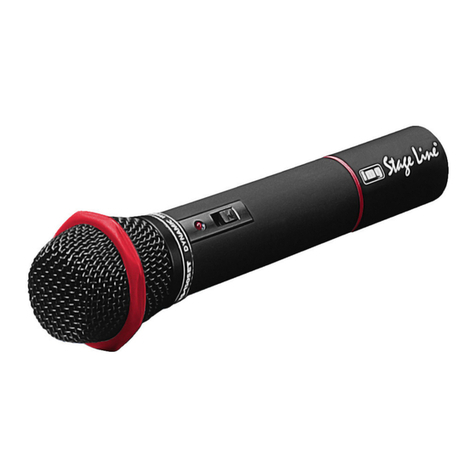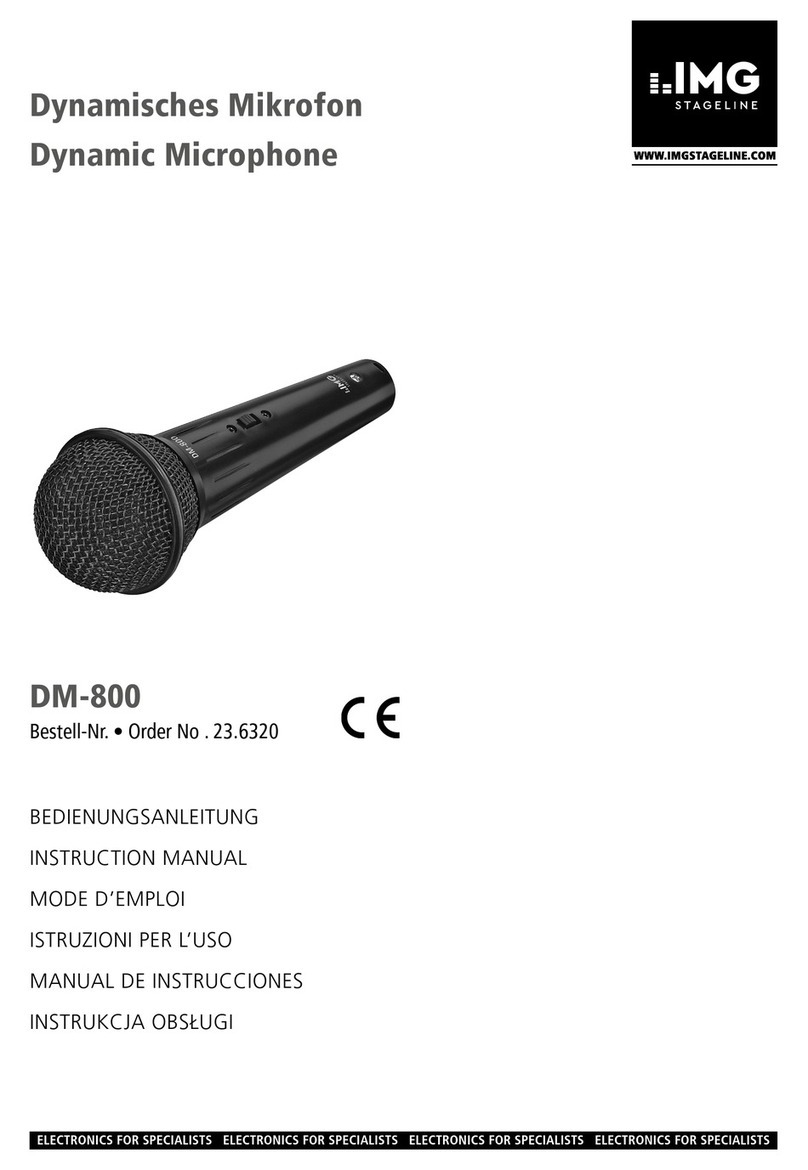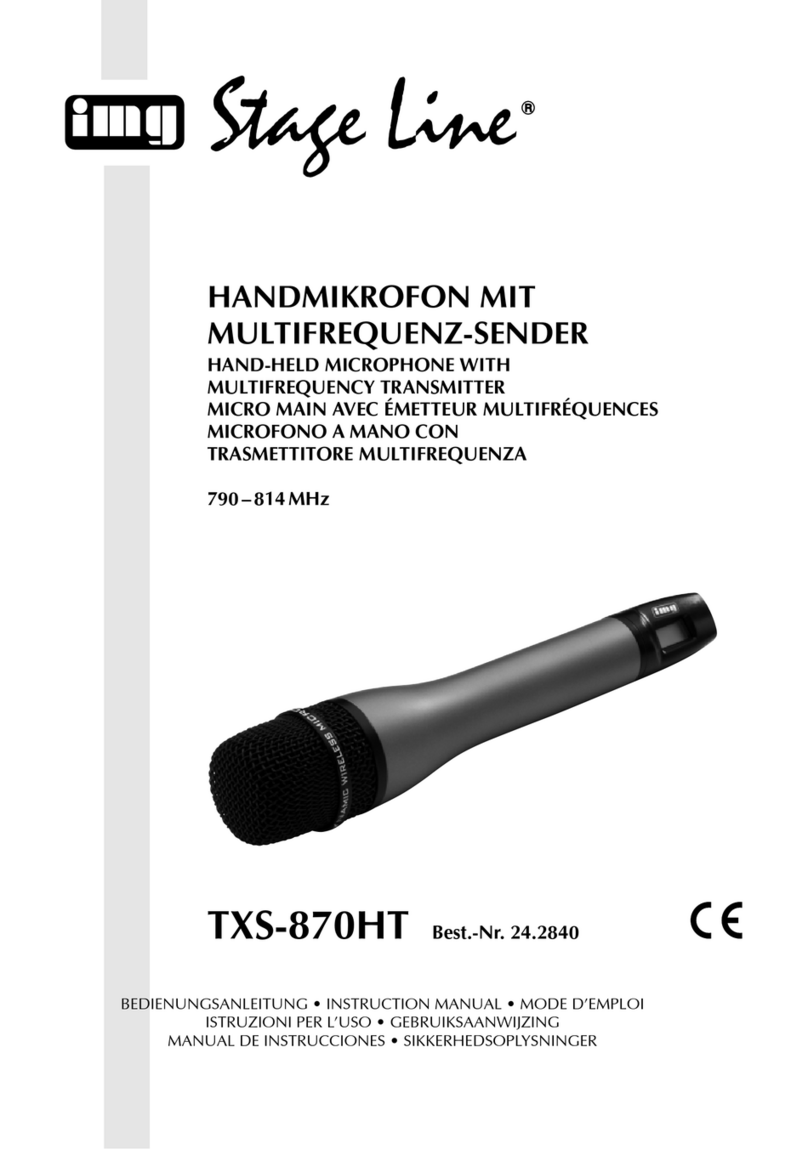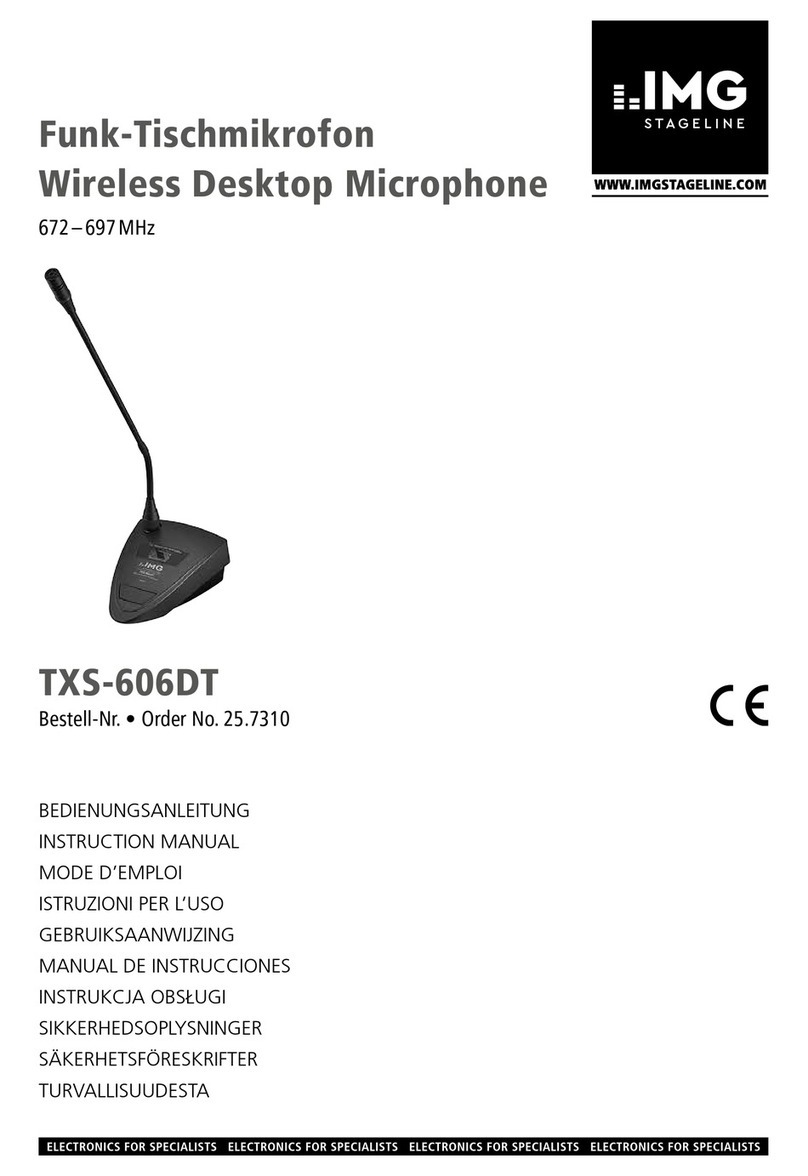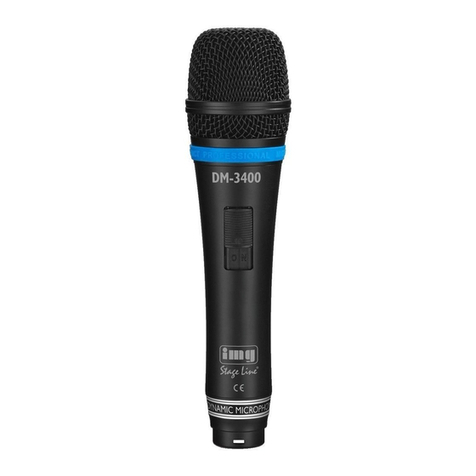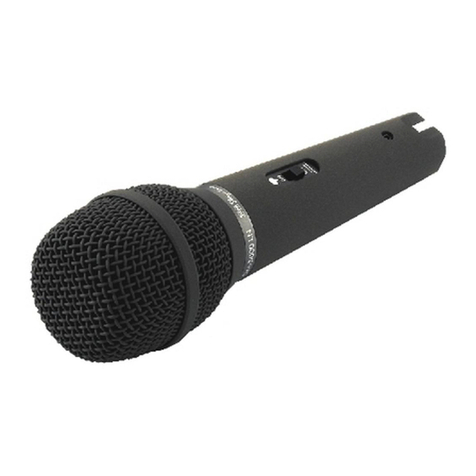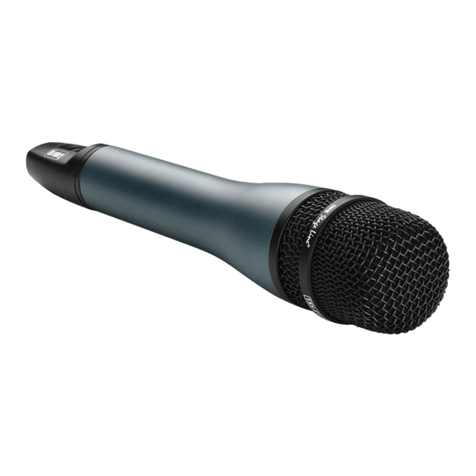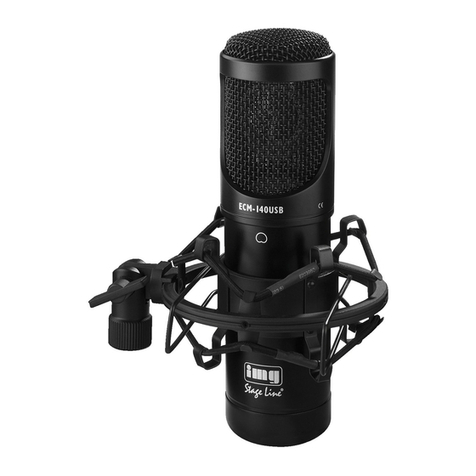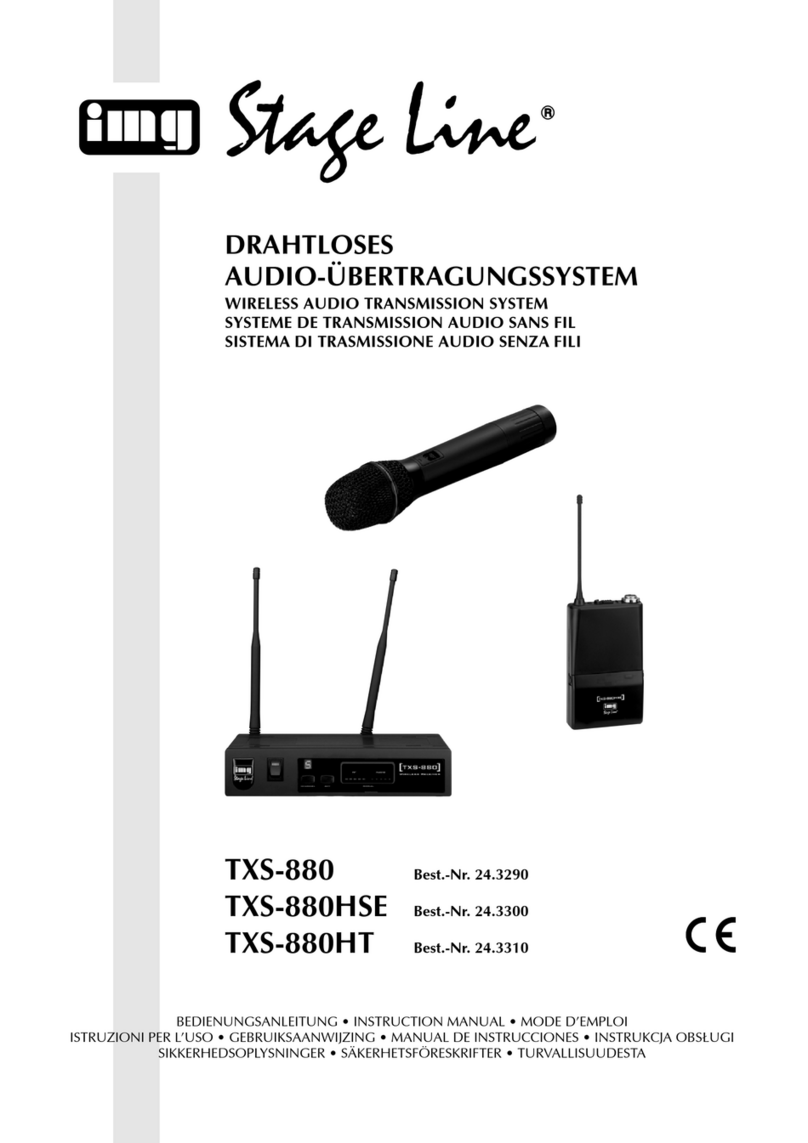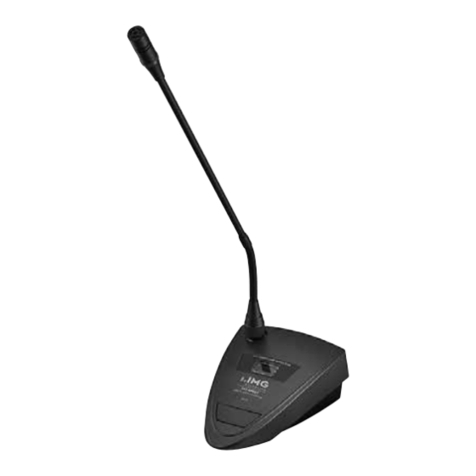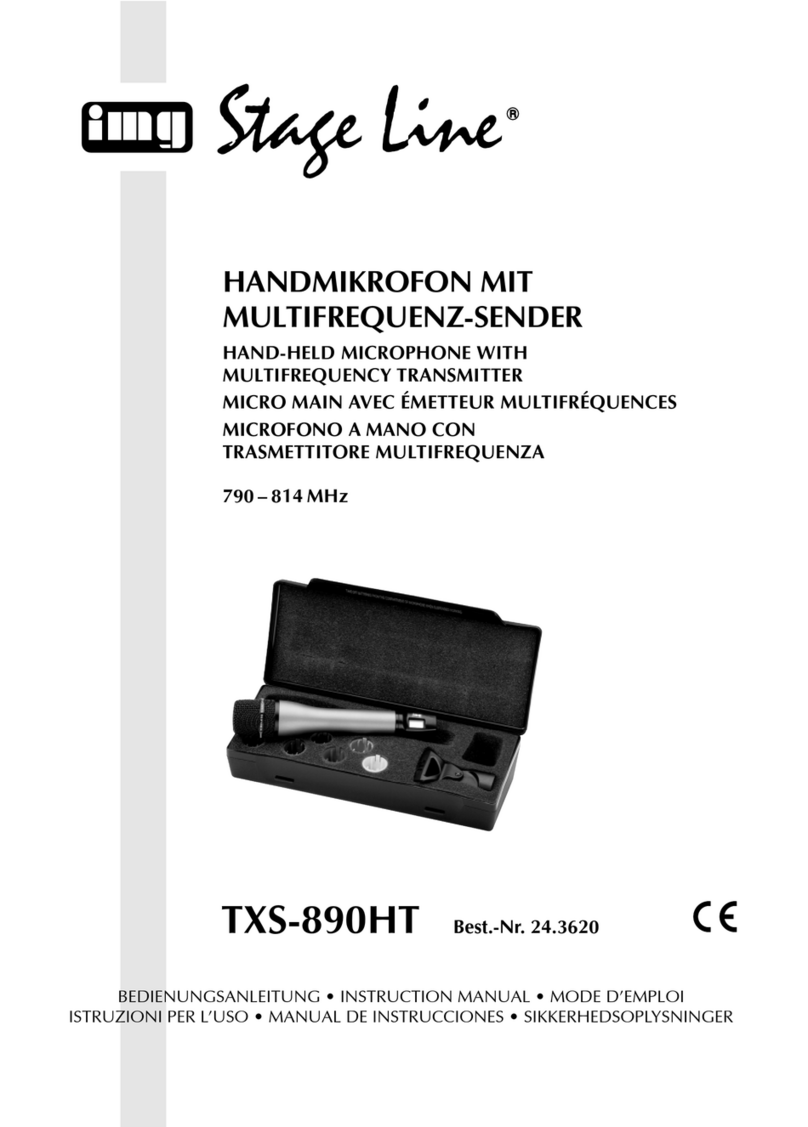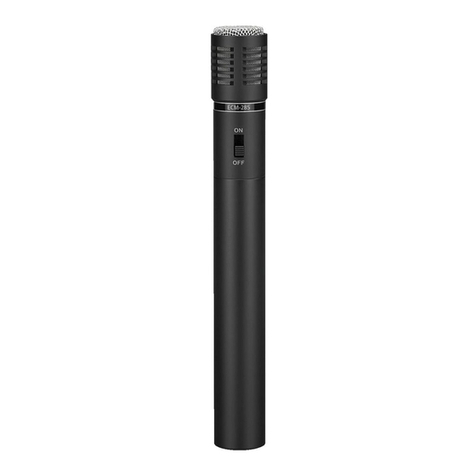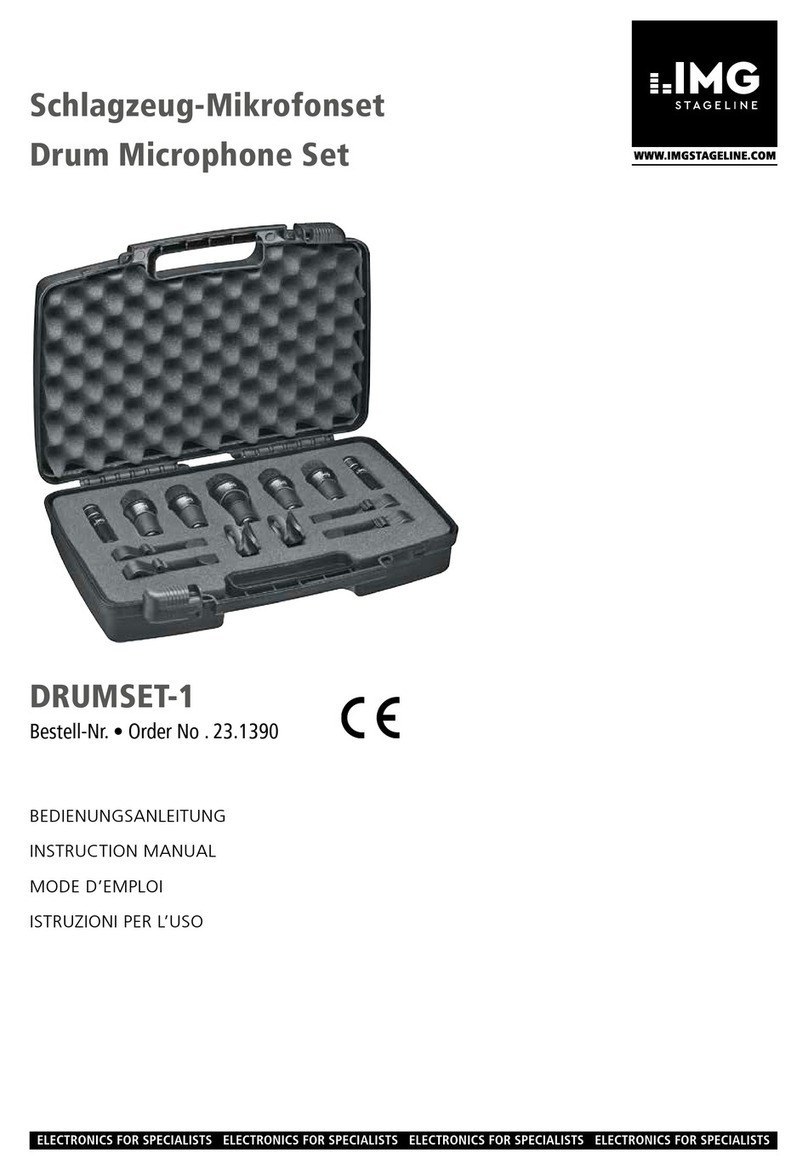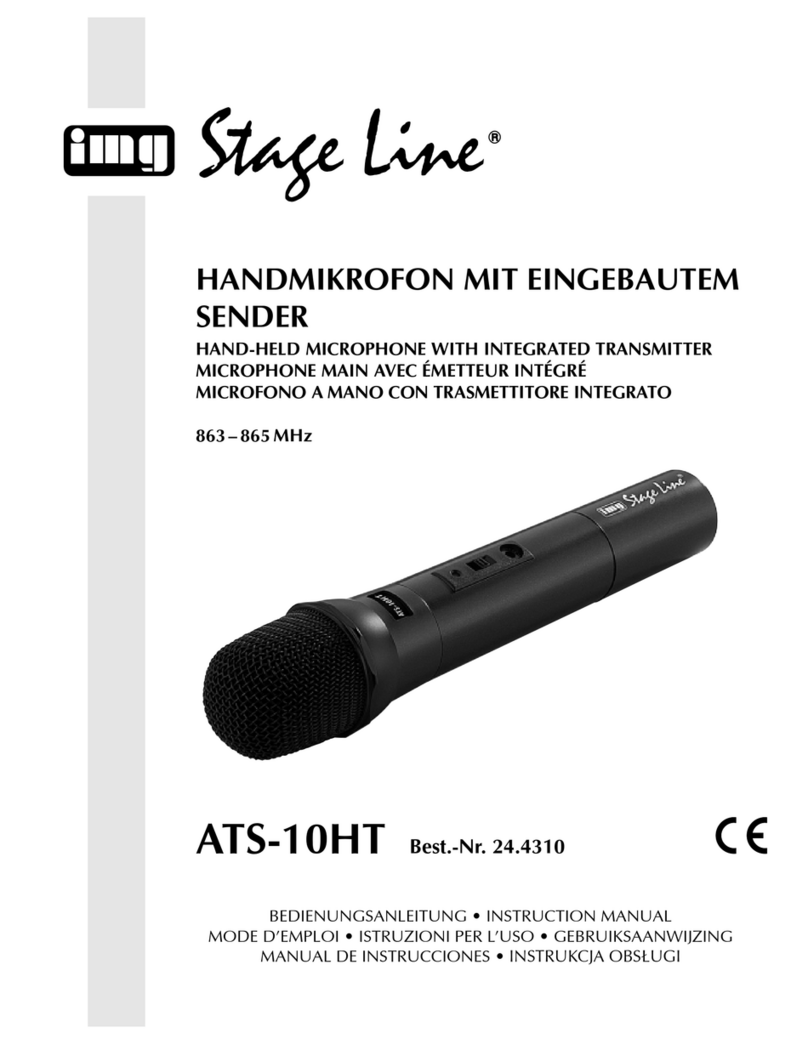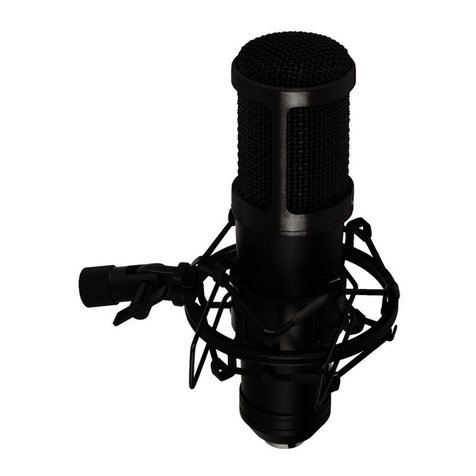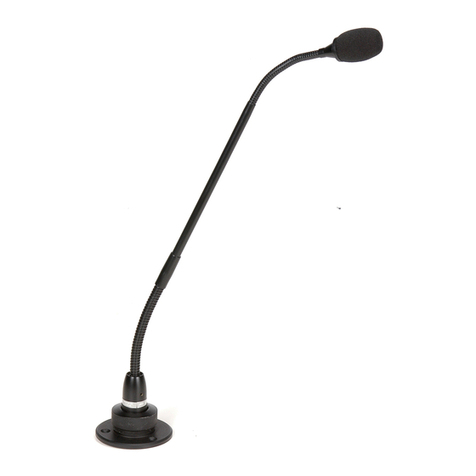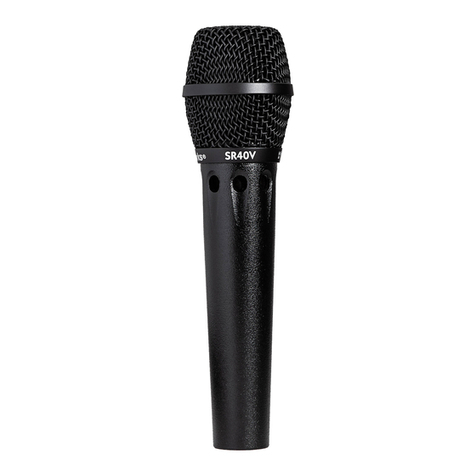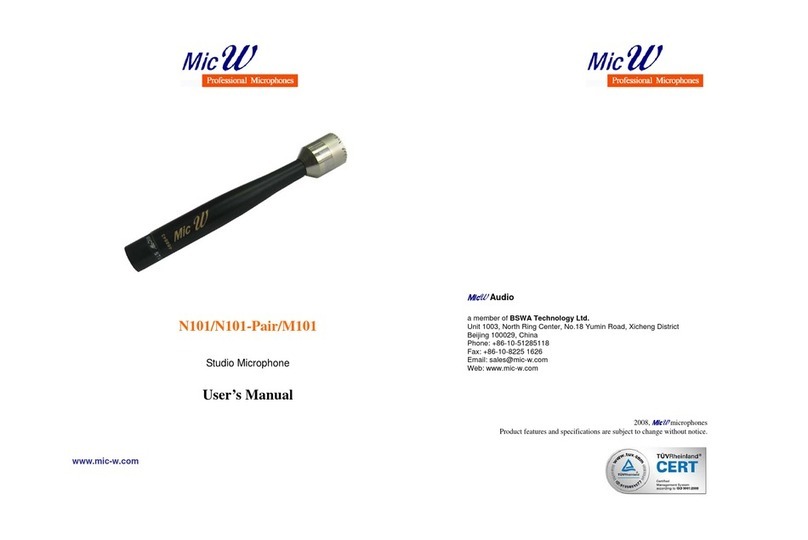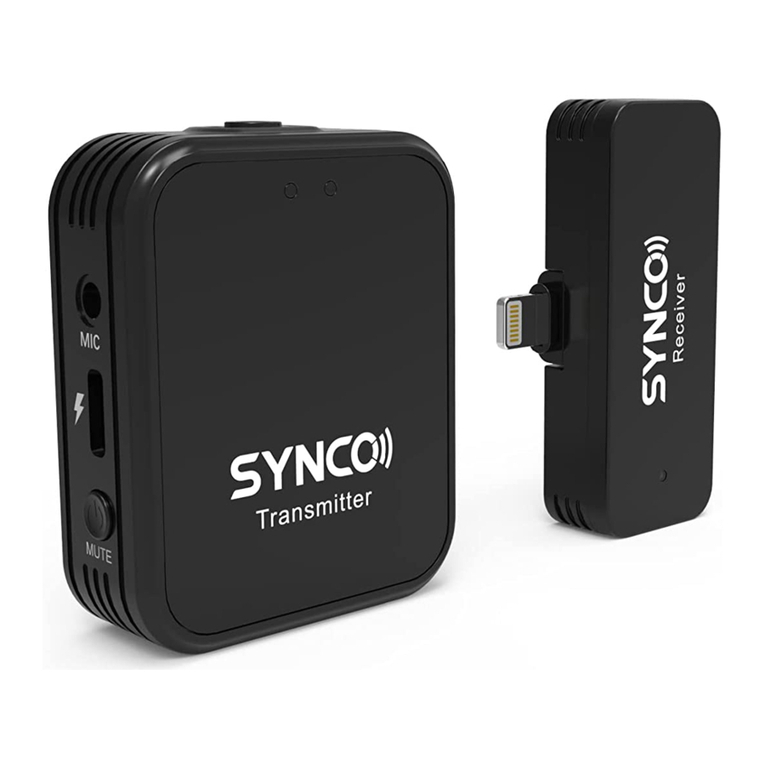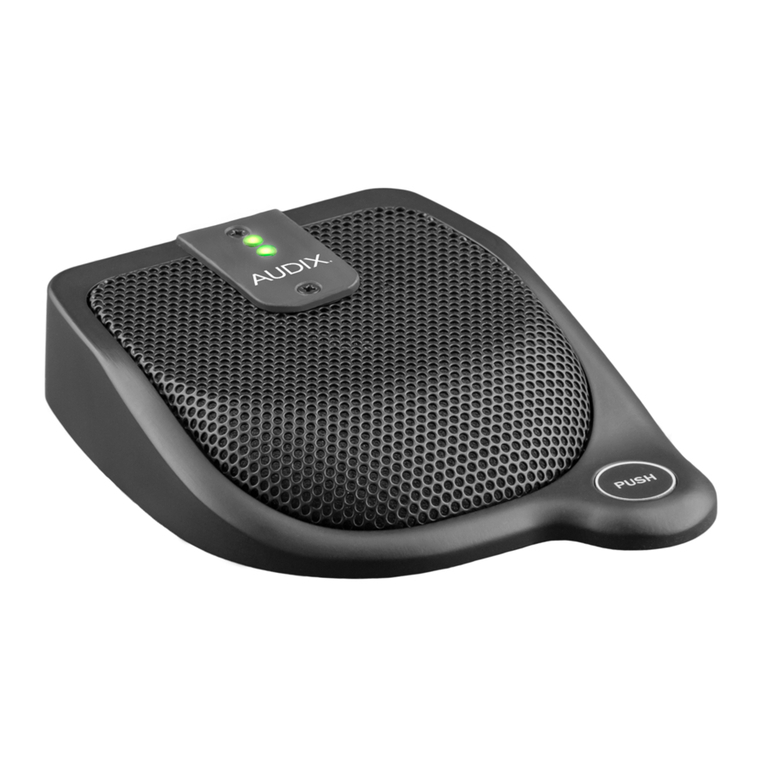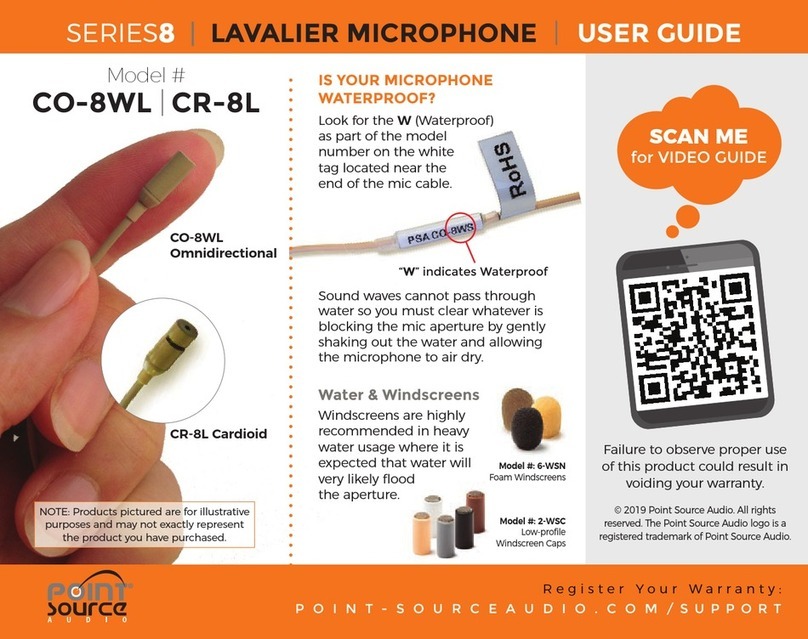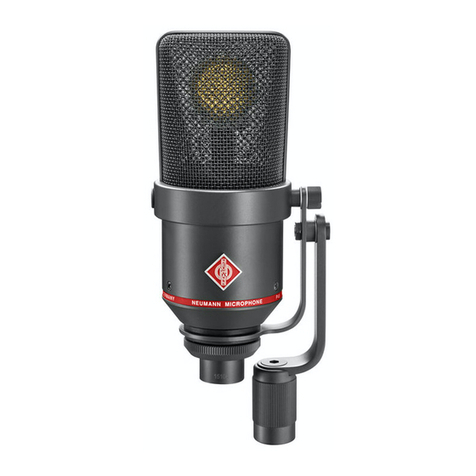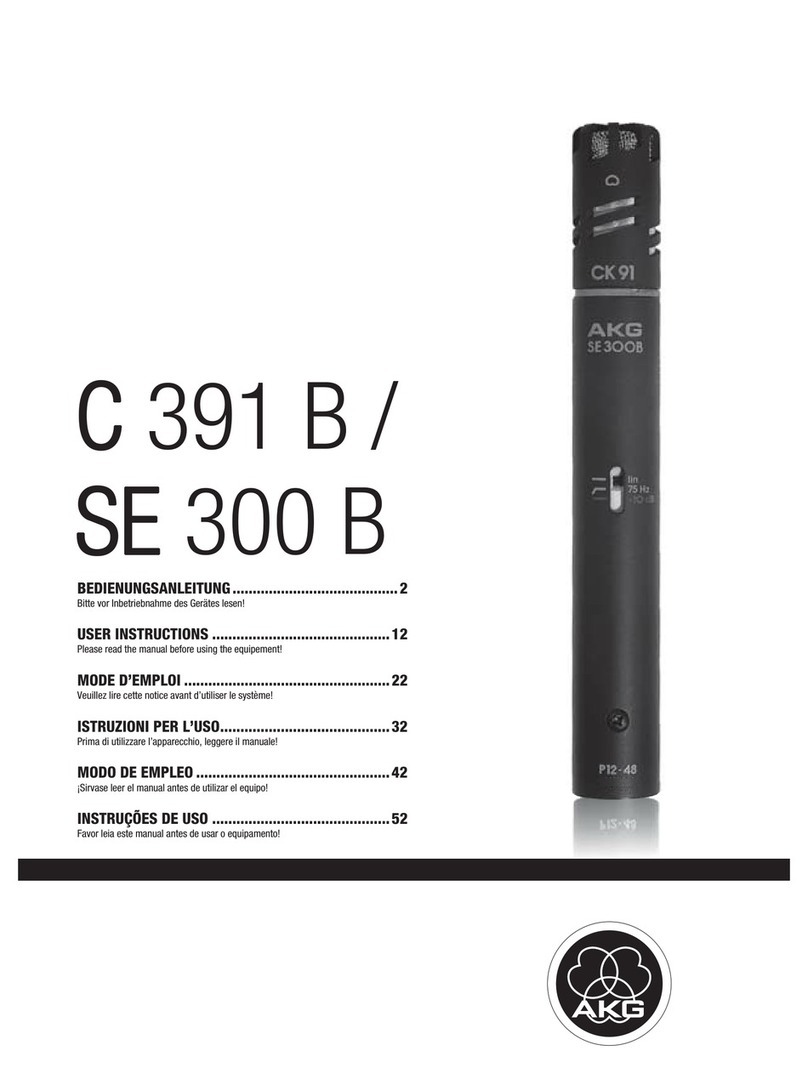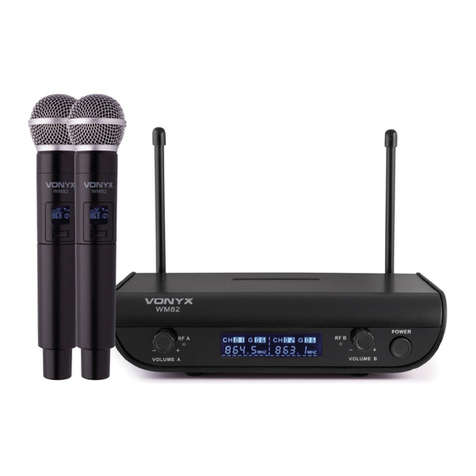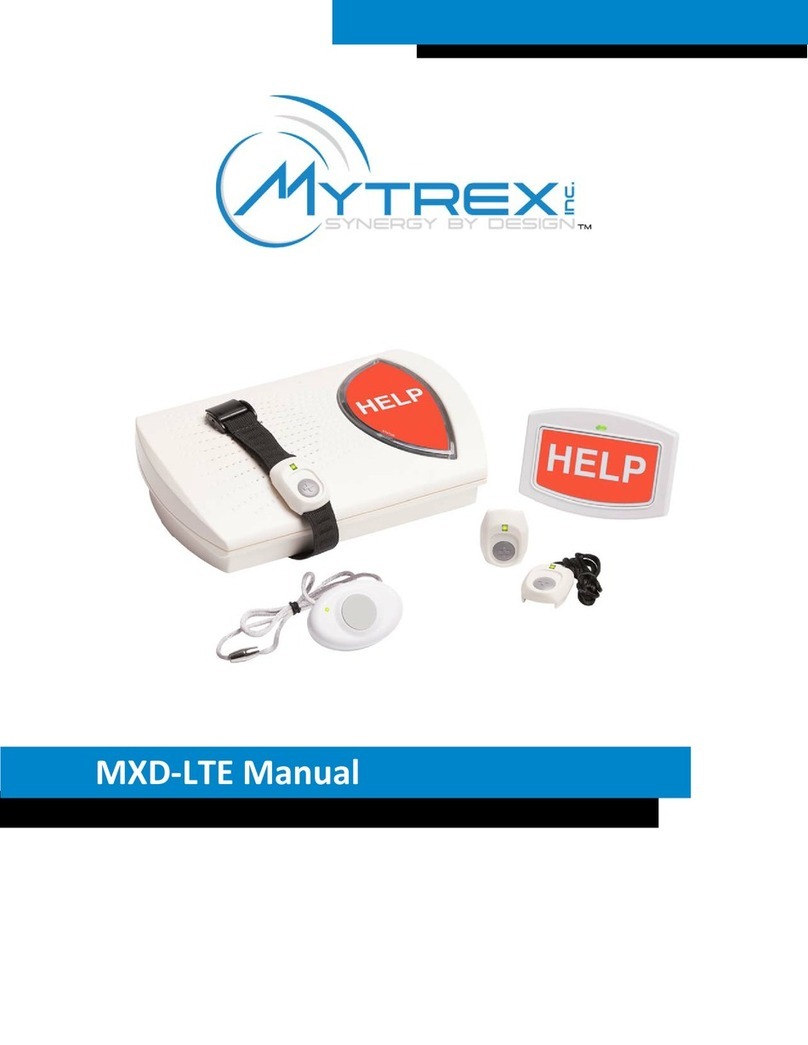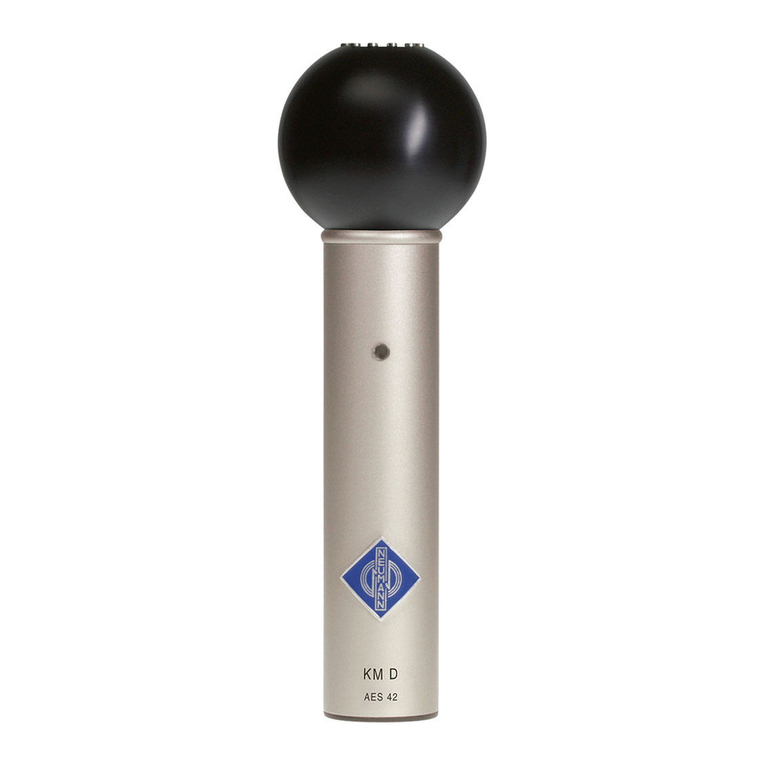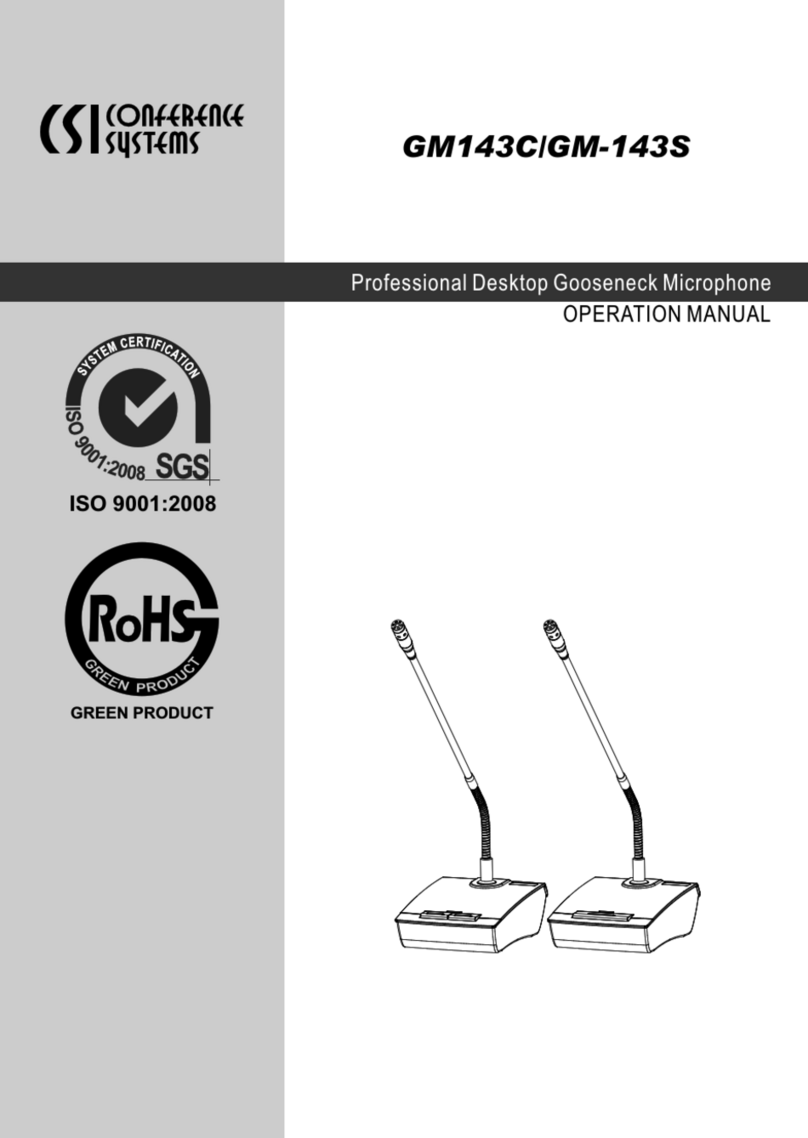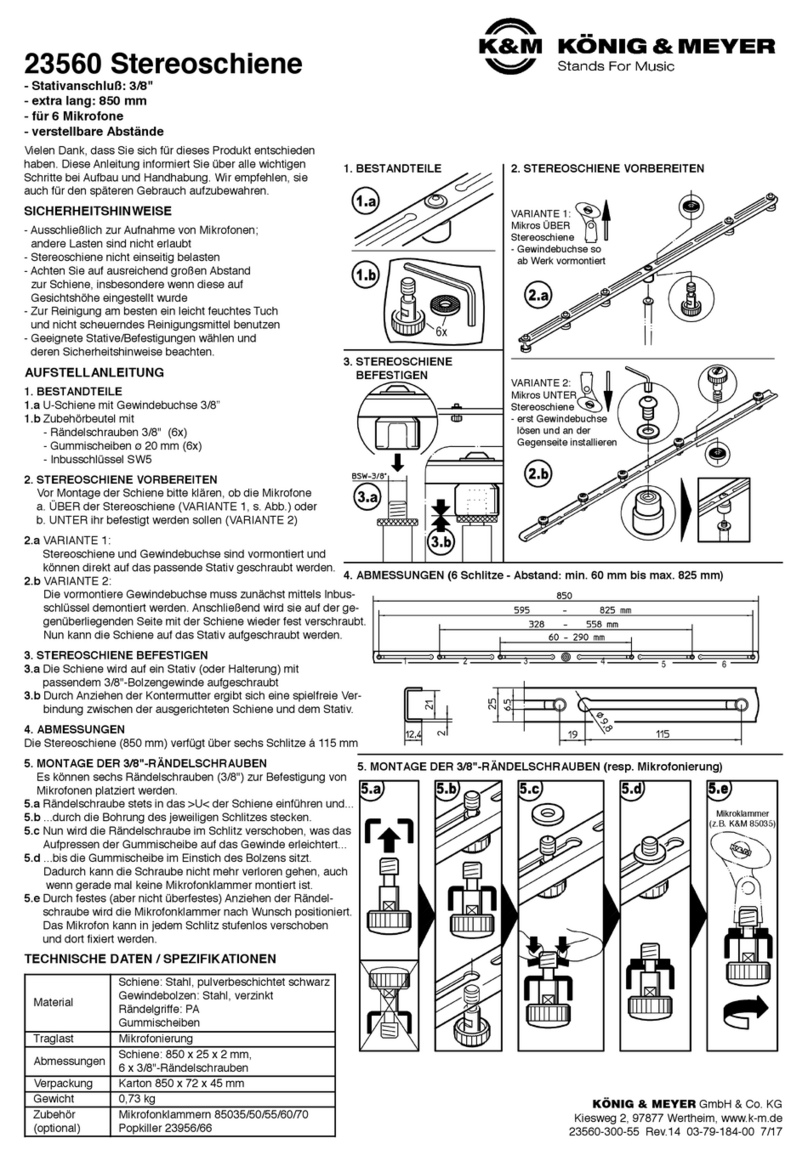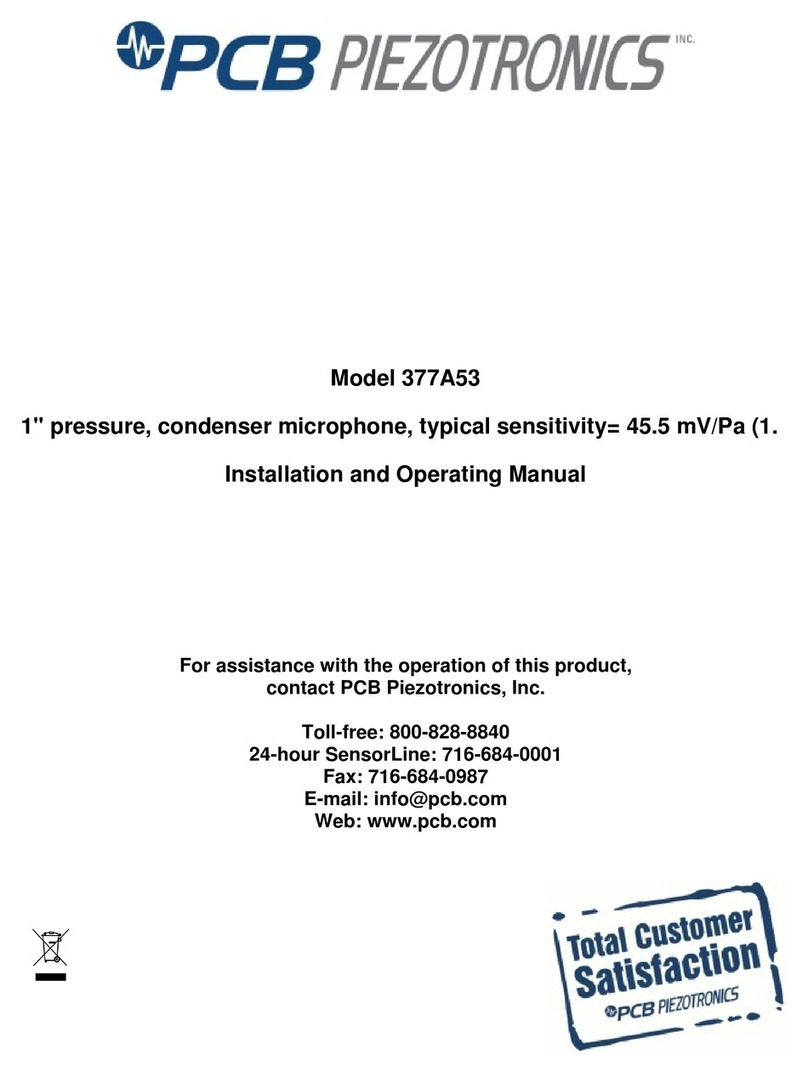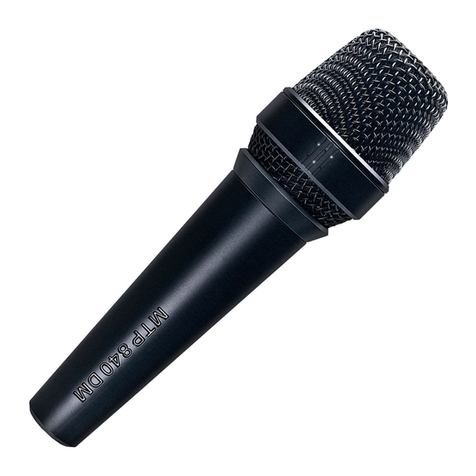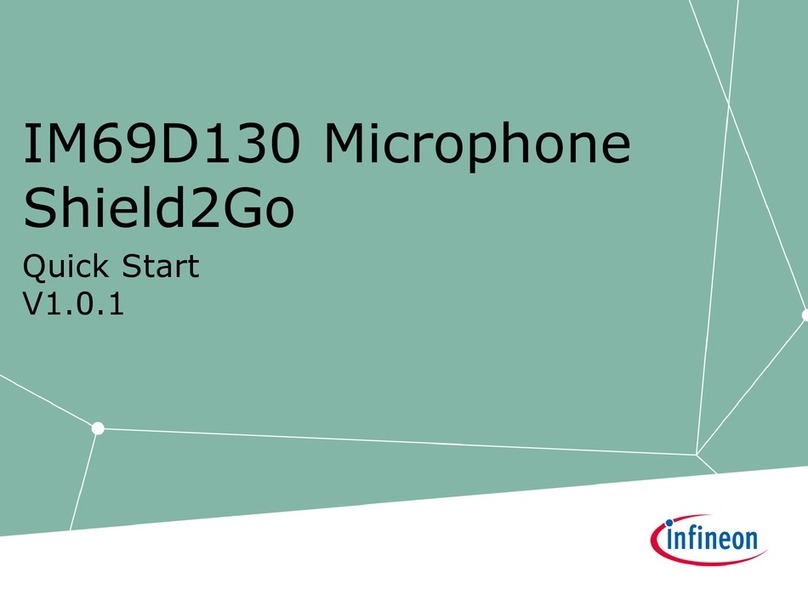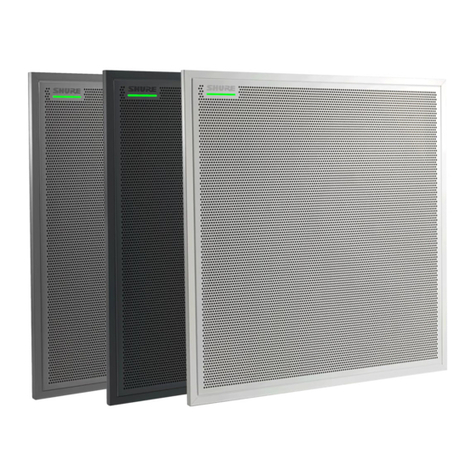ECM-170
Best.-Nr. 23.5520
www.imgstageline.com
Large Diaphragm Condenser
Microphone
Please read these operating instructions carefully
prior to operating the unit and keep them for later use.
1 Applications
This microphone with extra thin, gold-coated 25.4 mm
(1″) diaphragm is designed for professional studio
and live applications and is both suitable for the
sound pick-up of musical instruments and for vocal
sound. The directivity can be switched (bidirectional/
unidirectional/omnidirectional). The microphone is
operated with a phantom power of 48 V and has a
switchable low cut filter and a 10 dB attenuator switch.
The microphone is supplied with a case, a vibra-
tion-dampening support (spider), and a windshield.
2 Important Notes
The microphone corresponds to all relevant direc-
tives of the EU and is therefore marked with .
GThe microphone is only suitable for indoor use.
Protect it against humidity and heat (admissible
ambient temperature range 0 – 40 °C).
GFor cleaning only use a dry, soft cloth, never use
chemicals or water.
GNo guarantee claims for the microphone and no
liability for any resulting personal damage or mate-
rial damage will be accepted if the microphone is
used for other purposes than originally intended, if
it is not correctly connected, or not repaired in an
expert way.
If the microphone is to be put out of opera-
tion definitively, take it to a local recycling
plant for a disposal which is not harmful for
the environment.
3 Setting into Operation
1) Screw the spider onto a stand with 15.9 mm (5⁄8″)
thread or, with thread adapter, onto a stand with
9.5 mm (3⁄8″) thread. Press the two wire brackets
at the support together and insert the microphone.
2) To align the microphone, release the wing screw
at the spider, position the spider as desired with
the microphone inserted and retighten the screw.
3) Connect the microphone via a cable with XLR in-
line jack (e. g. a cable of the MEC series from “img
Stage Line”) to a microphone input of the audio unit
used, e. g. mixer. The microphone input must have
a 48 V phantom power supply. If the audio unit
does not provide any phantom power, connect the
microphone via a phantom power supply unit (e. g.
EMA-3 from “img Stage Line”) to the audio unit.
4) If required, place the windshield. It does not only
prevent the overemphasis of pop noise in case of
vocal sound but also protects the microphone
against the humidity of the breath.
3.1 Switch positions on the microphone
Adjust the three toggle switches (→see fig. 2) as
desired:
1) Adjust the directivity with the 3-position switch (1):
left position : bidirectional
The microphone responds most sensitively to
sound waves coming directly from the front or
from the back and not at all or only very poorly
to sound from the sides.
central position : unidirectional
The microphone responds most sensitively to
sound waves coming directly from the front and
less sensitively to sound coming from the sides
or from the back.
right position : omnidirectional
No directivity; the microphone responds to sound
from all directions with the same sensitivity.
2) To switch on the low cut filter (high pass) [e. g. for
a bass attenuation for compensating the close
talking effect], set the low cut switch (2) to the left
position .
3) For switching on the 10 dB attenuation for pick-
ing up sound sources with high sound level, e. g.
drums, brass instruments, set the attenuator
switch (3) to the right position
-
10 dB.
4 Specifications
System: . . . . . . . . . . . . . electret, pressure gradi-
ent microphone
Directivity: . . . . . . . . . . . . bidirectional/unidirec-
tional/omnidirectional
Frequency range: . . . . . . →see curves, fig. 1
Sensitivity: . . . . . . . . . . . 12 mV/Pa at 1 kHz
Impedance: . . . . . . . . . . 150 Ω
S/N ratio: . . . . . . . . . . . . > 80 dB
High-pass filter: . . . . . . . 200 Hz, 6 dB/octave
Attenuation switch: . . . . .
-
10 dB
Max. sound pressure
at 0.5 % THD: . . . . . . . . . 132 dB (142 dB at 10 dB
attenuation)
Power supply: . . . . . . . . . phantom power 48 V
Connection: . . . . . . . . . . XLR, balanced
Dimensions: . . . . . . . . . . ∅51 mm ×187 mm
Weight: . . . . . . . . . . . . . . 490 g
Subject to technical modification.
Microphone à
condensateur avec
grande membrane
Veuillez lire la présente notice avec attention avant le
fonctionnement et conservez-la pour pouvoir vous y
reporter ultérieurement.
1 Possibilités dʼutilisation
Ce microphone avec membrane 25,4 mm (1″), extrê-
mement fine et recouverte dʼor, est spécialement
conçu pour des utilisations professionnelles en stu-
dio et live et est également adapté pour des prises de
son dʼinstruments et des applications de discours et
chant. La caractéristique est commutable (bidirec-
tionnel/cardioïde/omnidirectionnel). Le microphone
est alimenté par une alimentation fantôme de 48 V
et dispose dʼun filtre Low Cut commutable et dʼun
atténuateur 10 dB.
Sont livrés un coffret, un support atténuateur de
vibrations (araignée) et une bonnette anti-vent/anti-
pop.
2 Conseils dʼutilisation importants
Le microphone répond à toutes les directives néces-
saires de lʼUnion Européenne et porte donc le sym-
bole .
GLe microphone nʼest conçu que pour une utilisation
en intérieur. Protégez-le de lʼhumidité et de la cha-
leur (plage de température de fonctionnement
autorisée : 0 – 40 °C).
GPour le nettoyer, utilisez uniquement un chiffon sec
et doux, en aucun cas de produits chimiques ou
dʼeau.
GNous déclinons toute responsabilité en cas de dom-
mages matériels ou corporels résultants si le micro-
phone est utilisé dans un but autre que celui pour
lequel il a été conçu, sʼil nʼest pas correctement
branché ou sʼil nʼest pas réparé par une personne
habilitée ; en outre, la garantie deviendrait caduque.
3 Fonctionnement
1) Vissez lʼaraignée sur un pied avec un filetage
15,9 mm (5⁄8″) ou, via un adaptateur fileté, sur un
pied avec un filetage 9,5 mm (3⁄8″). Appuyez
sur les deux étriers à fil sur le support et insérez le
microphone.
2) Pour orienter le micro, desserrez la vis papillon sur
lʼaraignée, positionnez lʼaraignée avec le micro
inséré comme voulu et revissez.
3) Reliez le microphone via un cordon avec une fiche
XLR femelle (par exemple un cordon de la série
MEC de “img Stage Line”) à une entrée micro de
lʼappareil audio utilisé, par exemple table de
mixage. Lʼentrée micro doit avoir une alimentation
fantôme 48 V. Si lʼappareil audio nʼa pas dʼalimen-
tation fantôme, reliez le microphone via une unité
dʼalimentation fantôme (par exemple EMA-3 de
“img Stage Line”) à lʼappareil audio.
4) Si besoin, positionnez la bonnette. Lors des utili-
sations de discours et chant, elle empêche non
seulement une accentuation excessive de sons
explosifs mais protège aussi le micro de lʼhumidité
de la respiration.
3.1 Réglages des interrupteurs
sur le microphone
Réglez les trois interrupteurs (voir schéma 2) comme
souhaité :
1) Sélectionnez la caractéristique avec lʼinterrup-
teur 3 positions (1) :
position gauche : bidirectionnel
Le microphone réagit de la manière la plus sen-
sible, aux ondes sonores venant directement de
lʼavant et de lʼarrière et pas ou de manière très
faible au bruit venant du côté.
Lorsque le microphone est définitivement
retiré du service, vous devez le déposer
dans une usine de recyclage adaptée pour
contribuer à son élimination non polluante.
position centrale : cardioïde
Le microphone réagit de la manière la plus sen-
sible aux ondes sonores venant directement de
lʼavant et moins aux ondes venant de lʼarrière ou
des côtés.
position droite : omnidirectionnel
Aucune caractéristique : le microphone réagit
au bruit dans toutes les directions de la même
manière.
2) Pour allumez le filtre Low Cut (passe-haut) [par
exemple pour diminuer les graves pour compen-
ser lʼeffet de parler près], mettez lʼinterrupteur Low
Cut (2) sur la position gauche .
3) Si lors de la prise de son de sources audio avec
un niveau sonore élevé, par exemple batterie, ins-
truments à vent, lʼatténuation 10 dB est allumée
en fonction, mettez le sélecteur dʼatténuation (3)
sur la position droite
-
10 dB.
4 Caractéristiques techniques
Système : . . . . . . . . . . . . électret, récepteur à gra-
dient de pression
Caractéristique : . . . . . . . bidirectionnel/cardioïde/
omnidirectionnel
Bande passante : . . . . . . →voir courbes, schéma 1
Sensibilité : . . . . . . . . . . . 12 mV/Pa à 1 kHz
Impédance : . . . . . . . . . . 150 Ω
Rapport signal/bruit : . . . > 80 dB
Filtre passe-haut : . . . . . 200 Hz, 6 dB/octave
Sélecteur dʼatténuation :
-
10 dB
Pression sonore max. pour
taux distorsion 0,5 % : . . 132 dB (142 dB pour atté-
nuation 10 dB)
Alimentation : . . . . . . . . . alimentation fantôme
48 V
Connexion : . . . . . . . . . . XLR, symétrique
Dimensions : . . . . . . . . . ∅51 mm ×187 mm
Poids : . . . . . . . . . . . . . . 490 g
Tout droit de modification réservé
®
MONACOR INTERNATIONAL GmbH & Co. KG
•
Zum Falsch 36
•
28307 Bremen
•
Germany
Copyright
©
by MONACOR INTERNATIONAL. All rights reserved. A-0768.99.02.11.2011
GB
FB CH




